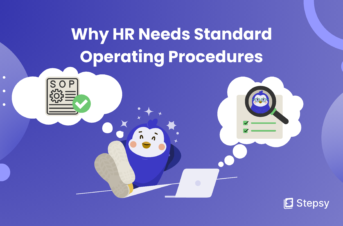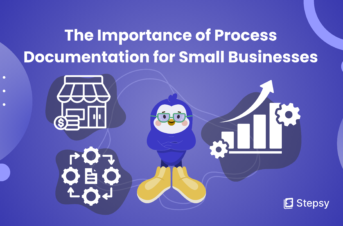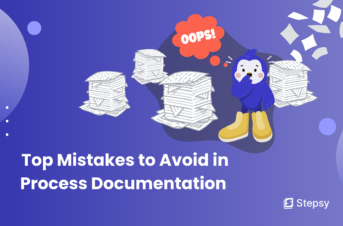Why are Training Manuals Important?
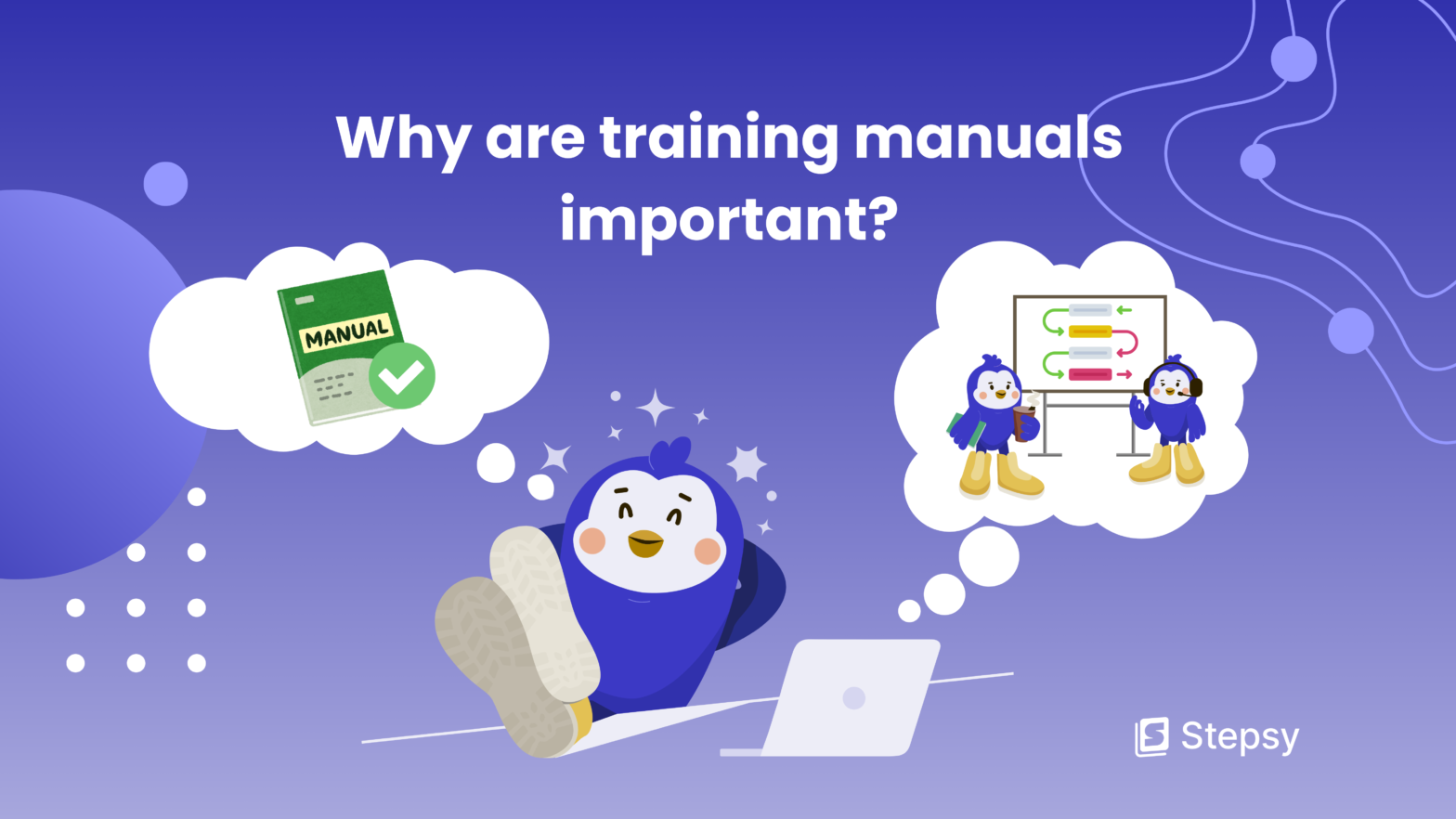
 Iryna Smuk • 27 Jun 2024
Iryna Smuk • 27 Jun 2024
Picture setting out on a journey through a dense, unfamiliar forest. The path ahead is fraught with ambiguity and dangerous situations without a map or guide. Now, consider a training manual as that significant road map that leads staff members through the intricate terrain of their roles and responsibilities within a company.
Similarly to a map, a training manual shows the route for staff members, ensuring they understand the procedures, expectations, and standards required to navigate their tasks successfully.
Definition of Employee Training Manuals
So, what is a training manual? Let’s define this type of documentation.
Training manuals are in-depth, step-by-step instructions created to provide guidance and information to individuals, facilitating learning and understanding of specific topics, tasks, or procedures. They typically contain detailed content that can be referenced repeatedly, aiding in reinforcing education and developing skills.
Generally, these manuals come in different formats for different uses. Below is a summary of some common types of training manuals:
| Name | Description |
| Employee Handbook | This manual offers an overview of company policies, culture, and procedures. It covers various topics, such as organizational structure, code of conduct, benefits, disciplinary procedures, and expectations. |
| Task Manual | This manual gives detailed instructions on how to perform certain duties effectively. These manuals are especially useful for roles that require adherence to standardized procedures. |
| Project Manual | This manual outlines the procedures, roles, responsibilities, and timelines associated with a specific project. It is essential for coordinating efforts among team members and stakeholders. |
| Safety Manual | This manual presents best practices and regulations for potentially hazardous tasks or environments. It covers topics such as emergency procedures, proper use of equipment, hazard communication, and occupational health standards. |
| Technical Manual | This manual provides specific instructions on the operation, maintenance, and troubleshooting of equipment or systems. Also, it often includes diagrams, step-by-step procedures, and technical specifications. |
Benefits of Training Manual
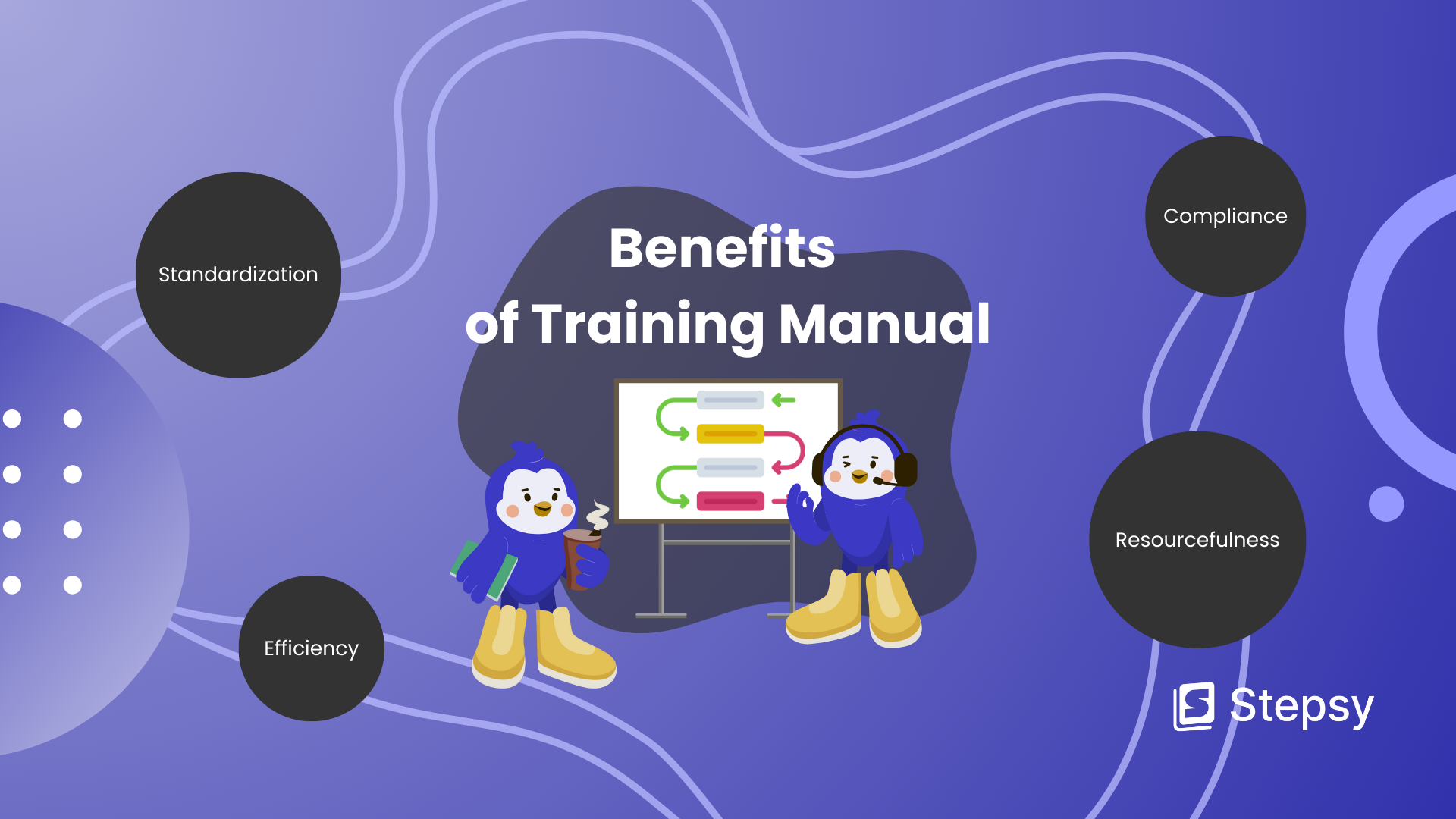
Numerous advantages of training documentation help to create a happier and more productive work atmosphere. Here are some of the most powerful training manual benefits:
- Standardization: Regardless of location or teacher, training documents present uniform training among employees. Organizations can preserve quality and reliability in their operations with standardized procedures outlined in manuals.
- Efficiency: Training manuals for employees expedite the training process by including step-by-step instructions. This way, new workers can quickly grasp information and procedures, resulting in faster integration into the workspace.
- Resourcefulness: Good employee training guides operate as a reliable reference document for staff after initial training. Thus, there is no need for supervisors or colleagues for guidance. Workers can independently refer to manuals in order to refresh their knowledge or troubleshoot issues.
- Compliance: Quality employee training manuals can help organizations meet legal and regulatory requirements. They clearly outline policies, safety protocols, and procedural guidelines. This approach guarantees that the workforce is informed about industry standards and best practices, mitigating the risk of non-compliance and associated penalties.
Components of an Effective Training Manual
Clear Objectives

An effective training manual starts with clearly defined objectives. It sets the stage for the entire training program and provides a roadmap for both trainers and trainees.
For example, an employee training handbook might aim to:
- Familiarize new hires with company culture and values.
- Explain employee benefits and compensation structures.
- Outline workplace policies and procedures.
It is important to outline the specific skills, knowledge, or behaviors that should be developed. The next step is to establish criteria for evaluating the success of the training and development that can be tracked and assessed. Therefore, the manual sets expectations and ensures new employees have a strong foundation for success in their new roles.
Structured Content

After establishing objectives, the content of the training manual needs to be well-organized and logically structured. A good structure facilitates a smooth learning flow as well as makes it easier for trainees to navigate the training information. Here we have some recommendations for creating an effective structured training manual:
- Organized Sections: Divide the manual into clear, manageable sections, each focusing on a particular aspect of the training. Include chapters, modules, or units based on the material’s complexity.
- Logical Flow: Arrange the content in a sequence that builds upon previous sections, gradually increasing complexity.
- Consistency: Use consistent formatting, terminology, and style throughout the manual.
- Summaries and Reviews: Put summaries at the end of each section or chapter to reinforce key points and provide opportunities for review.
Visual Aids

Since the human brain processes visuals much faster than text alone, it is a must-have to integrate different visual elements. Training content with such materials makes understanding and retention of key information easier. Consider utilizing some of these visual aids:
- Images: Use images to break up text and illustrate key concepts.
- Diagrams: Incorporate diagrams to explain processes and relationships between different elements.
- Charts and Graphs: Employ charts and graphs to present trends, data comparisons, or performance metrics.
- Infographics: Create infographics with text and visuals for summarizing key points and making complex data more accessible.
Instructions

Clear instructions are critical for many tasks. Comprehensive training manuals should provide step-by-step procedures and guidelines that are easy to follow. Instructions also reduce the need for constant supervision. Here are we offer some key elements of potent instructions:
- Step-by-Step Procedures: Clearly outline each step involved in a task and make them easy to follow.
- Examples and Scenarios: Provide real-world examples and scenarios to demonstrate the application of the instructions.
- Troubleshooting Tips: Include common issues that might arise and their solutions.
Quizzes and Assessments

Other beneficial components of powerful training manuals are quizzes and assessments. Implementing such elements at the end of each section or chapter allows trainees to test their understanding of the training material. These are some of our suggestions:
- Quizzes: Include short quizzes to test trainees’ immediate understanding of the material.
- Assessments: Conduct more comprehensive assessments at the end of the training program to evaluate overall understanding.
- Scenario-Based Questions: Incorporate scenario-based questions that require trainees to apply what they have learned to real-world situations.
- Interactive Elements: Use interactive elements like online quizzes, simulations, or gamified assessments to make the process more engaging.
- Feedback: Provide feedback on quizzes and assessments to help trainees understand their strengths and areas for improvement.
Role of Training Manuals in Employee Onboarding
Creating an employee training manual is undeniably fundamental for the onboarding process. It can be considered as one of the best tools that help new employees acclimate quickly and effectively. Throughout onboarding, new hires are bombarded with a wealth of information, but manuals help them manage this influx.
According to the research of The Wynhurst Group, new hires who participated in a structured onboarding program were 58% more likely to be with the organization after three years.
A well-organized training manual is a great solution because it provides a structured learning culture — hence ensuring that all new employees receive the same information and welcoming process.
Organizations should also use a training manual to introduce new staff members to the company’s culture, values, and mission. Additionally, creating training manuals empowers new hires to take ownership of their learning process, fostering a sense of independence and problem-solving skills.
Best Practices for Creating Training Manuals
Now that we understand the importance and core components of training manuals for your employees, we need to look into some best practices for creating comprehensive guides:
- Keep it Simple: Use plain language that is easy to understand, avoiding jargon or technical terms except where necessary.
- Engage the Reader: Grab readers’ attention by incorporating interactive elements where possible, consider the use of images, diagrams, charts, and infographics to enhance understanding and split up the sections of text that are too heavy.
- Regular Updates: Maintain the manual up-to-date with respect to modern procedures, regulations, policies, and best practices within the organization. In addition, make sure employees are aware of all changes. Archive previous versions for reference if needed.
- Feedback Mechanism: Integrate mechanisms for users to provide feedback on the manual. For example, include surveys, suggestion boxes, or online forms where employees can comment on the clarity, usefulness, and relevance of the content. Then use these insights to make continuous improvements.
- Accessibility and Usability: Ensure that all employees responsible for the specific procedure have access to respective manuals. It is useful to use shared drives.
- Tools: The automation of creating, managing, and sharing effective employee training guides saves the time needed for its building. Some user-friendly software or online platforms eliminate the need for doing the tedious work of building them manually. Additionally, they can equip you with templates or auto-generating features for creating a training course.

Future of Training Manuals
With the evolution of technologies, new trends are expeditiously coming out in the field of training content creation. At Stepsy, we are sure that in the future training manuals will go digital to a greater extent, even if printed versions will probably be around for a little longer. Digital manuals make it possible for an employee to access training materials anytime he wants on any device — therefore offering more accessibility and flexibility compared to traditional manuals where one has to be at a certain physical location within specific working hours to attend classes.
Another trend is interactive guides that engage learners through hands-on activities, quizzes, branching scenarios, and gamified elements. It is beneficial for motivating employees to participate and retain knowledge actively.
E-learning platforms are also promptly transforming the training scene. They offer powerful analytics and reporting capabilities, along with features to track learner progress, measure training effectiveness, and identify trends or areas requiring additional focus.
The growing trend of artificial intelligence (AI) is also influencing training opportunities. AI-powered training manuals can analyze learner behavior and performance data to deliver adaptive learning experiences. Natural language processing (NLP) capabilities in AI can enhance user interaction with training manuals by enabling voice commands, chatbots for instant assistance, and intelligent search functionalities.
Conclusion
Hence, training manuals are undoubtedly in implementing any organization’s training strategy. They are thorough documents designed in order to provide employees with the knowledge and skills they need to perform their roles effectively. They have plenty of benefits, such as ensured standardization, increased efficiency, reduced dependency on supervisors, and maintained compliance. Organizations have a variety of types of training manuals to choose from — employee handbook, task manual, project manual, safety manual, or technical manual. Furthermore, training instructions are an integral part of the employee onboarding process, helping new hires acclimate quickly and effectively.
A competent training manual should contain clear objectives, well-organized content, visual aids, and interactive elements to be more engaging and productive. The best practices show that it is critical to use simple, easy-to-understand language, engage readers with interactive elements, maintain the manual regularly, incorporate feedback mechanisms, guarantee accessibility, and use tools like automated software or online platforms.
With the evolution of technologies, the future of training manuals will undoubtedly include the increasing use of digital manuals, interactive guides, e-learning platforms, AI, and machine learning.
So, stay ahead of the curve, and implement training manuals for your business today!
